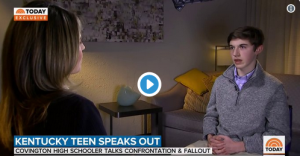How the media covers whiteness: “Today,” Nicholas Sandmann and “the others”
< < Go Back
Savannah Guthrie’s interview with the Covington Catholic teen shows an ongoing flaw in how the news covers race
Kudos to NBC’s Savannah Guthrie for clarifying the core context of heated conversation regarding what happened over the weekend outside the Lincoln Memorial crystal clear: See, this is about white people and “others.”
How are innocent children expected to react to “others”?
And, “What’s this been like for you and for your family?”
Shuffled within this line of questioning, though, are queries that have a bit of historical and cultural weight to them.
“Did you feel threatened at all?. . . There were more of you than them, but you felt like, they were stronger?”
Then comes the moment that made me audibly groan: “Have you looked at that video and thought about how it felt from the others’ perspective? In other words, there were a lot of you, a handful of the others. Do you think they might have felt threatened by a bunch of young men kind of beating their chests?”
See? It’s all about confusion over what to do with those “others.”
Yet as Guthrie questioned Sandmann, she kept using the term “others” in reference to anyone present who wasn’t a Covington kid. To the casual viewer, that might not mean much. One suspects Guthrie was simply attempting to handle a difficult line of questioning to a minor as gently as possible.
But in a conversation about members of three groups from disparate cultural backgrounds coming into conflict, including one that’s been consistently attacked and exploited by dominant powers and frequently dismissed by the media, referring to the two who aren’t white as “others” has thorny connotations.
The concept of “other,” in this context, has long been explored in phenomenology. Within the last three decades it’s also been defined as viewing or treating people who are differ from a dominant group as alien.
“Others” recognize the teens’ reaction as an intimidating chant — appropriate for high school sporting matches, maybe not so much when facing down people you’ve never met who are participating in the Indigenous Peoples March taking place on the Mall.
When part of that response also appears to be an appropriation of a haka, a Maori war dance, the argument over it being peaceful and positive becomes less convincing. That is, unless it is presented before a sympathetic interviewer who doesn’t even point out that their “school spirit” effort is usually employed to intimidate opposing teams at sporting events. Nor does she even mention the term “haka.”
eparate conversations can and should be had over what this entire moment indicates about the responsibility the Covington Catholic parents bear to educate their kids about basic rules of interaction with strangers in unfamiliar public spaces, let alone in one popularly thought to be one of our nation’s most hallowed.
There’s also much to be written about what Friday’s interaction tells us about the ways that schools are failing to adequately educate the next generation about our history and, in a bleaker context, how adults are complicit in sowing such seeds of ignorance. If these kids knew anything about Native American culture or history, they might have some inkling that what was being captured on camera was, at the very least, not a good look to show the world.
More From Salon:




